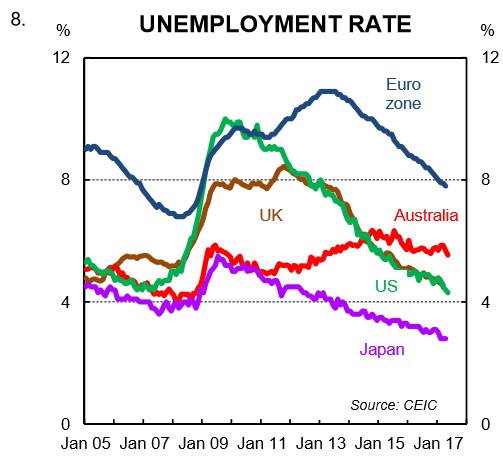The Australian’s business columnist, Terry McCrann, is the latest high profile figure to question the efficacy of Australia’s turbo-charged immigration program, penning the following over the weekend after recently returning from a holiday in Japan:
In Japan ‘‘things’’ worked and worked well. Drawing on the old saying, in Japan the trains run on time; and indeed, extending the metaphor, so does everything else. In Australia neither the trains literally — nor ‘‘the everything else’’ figuratively — do. Indeed, in Melbourne on Friday they didn’t run at all.
I want to look at that ‘‘big picture’’ around the most fundamental difference — in both societal and economic terms — between the two countries: population growth.
…we tended to view Japan rather condescendingly as ‘‘not working’’ because of its negative demographics and very low overall economic growth.
As the reverse is actually the case, it should give us pause, very considerable pause, about our assumptions, about our policy arrogance and indeed both the policy choices and their, for want of a better word, implementation.
Australia has of course had an uninterrupted immigration-led population growth strategy for 70 years, since the end of the World War II. But in the last decade or so we have sleepwalked into a policy of immigration-on-steroids…
The ‘‘Big Australia’’ debate has belatedly got under way. There’s a growing awareness that population-led growth is not free, but it might well be delivering profitless prosperity.
Double the population and, yes, you might double the economy — or even do better than that in macro economic terms; but once the — on balance, negative — tangible and intangible micro factors are included, it is arguably an overall negative…
Sacrificing some excess growth for livability seems a worthwhile trade. Sacrificing livability for a bigger economy statistic does not. But in any event the greater part of Australia’s strong (per capita) growth was actually last century. Over the past 10 years — which included the peak and re-peak of the mining boom — Australia’s per capita growth rate was just 1.2 per cent a year.
I note this period also includes the peak of negative livability. Further, that’s only going to worsen, especially in Melbourne and Sydney. We face the prospect of not even having the ‘‘high growth’’ partial offset.
…over the last five years, Japan’s per capita growth rate has been higher than Australia’s — running at 1.35 per cent a year as against our 1.25 per cent. That’s to say, Japan’s been getting to have its zero population growth livability and getting to eat its bigger economic cake as well.
We haven’t been getting much of the cake and a heap of negative livability…
Look across the infrastructure board and across the nation: is there anywhere where the infrastructure has led?…
That hopelessness actually lies at the core of the immigration stupidity.
It means first, giving away our existing infrastructure free. It then requires the previously resident population to pay for most of the new infrastructure, even on the dubious assumption that newcomers all get jobs and pay taxation relatively pro-rata to the previous population.
McCrann makes a lot of excellent points. Australia’s immigration intake and population growth has indeed been on “steroids”:
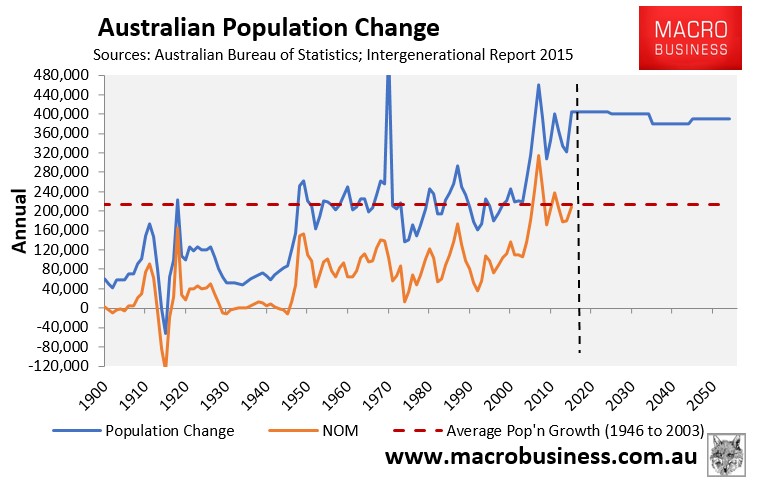
In the 12 years to 2016, Australia’s net overseas migration (NOM) averaged an insane 210,000 people a year, which is roughly triple the average of 70,000 in the century following Federation. Moreover, this turbo-charged migrant intake is projected to continue until mid-century, effectively adding a Canberra to Australia’s population each and every year, or a Perth every five years, over the next three-plus decades.
Sadly, Australia’s per capita GDP growth has plummeted over the past 12 years just as immigration has boomed. In fact, long-run trend per capita GDP growth has cratered to levels below the early-1980s and 1990s recessions:
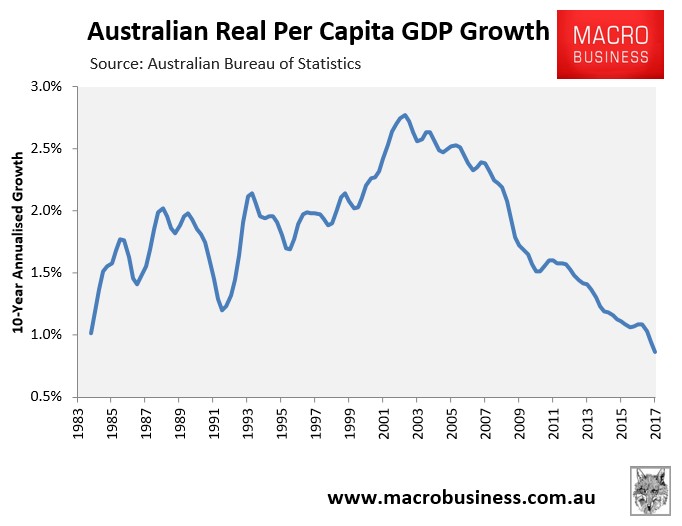
To add insult to injury, real per capita wages & salaries have also fallen nearly 2% over the decade to March 2017:
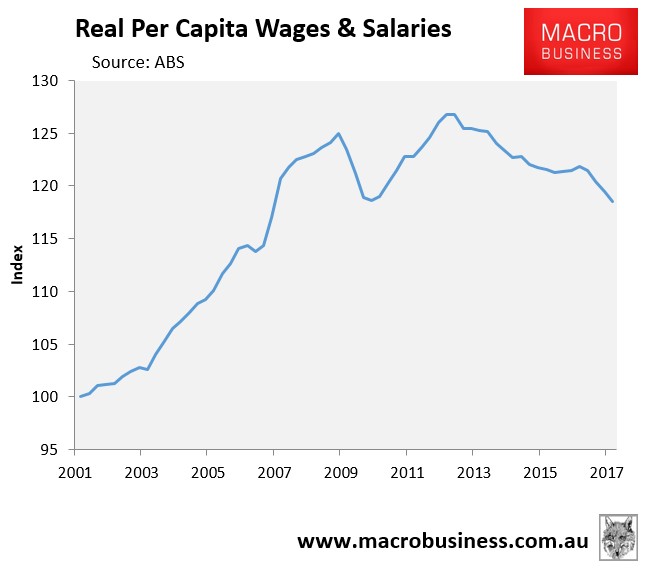
When you add negative externalities, such as increased congestion in our major cities, the need for expensive new infrastructure to be built (paid for largely by the incumbent residents), smaller and more expensive housing, as well as damage to Australia’s natural environment, then it is clear that Australia’s “policy of immigration-on-steroids” is wrecking living standards.
McCrann’s comparison with Japan is also apt. Too often country’s like Japan, which have declining populations, are derided by Australian commentators as being economic basket cases. Yet, the data does not support this view.
As shown in the next chart, there were five OECD nations that experienced declining populations between 2003 and 2015. These are charted below against Australia’s mass immigration population ponzi:
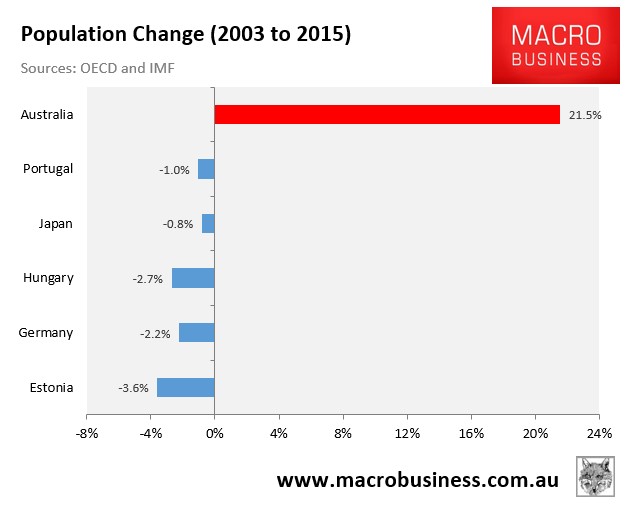
If it was true that population growth was such an economic boon, then you would expect that GDP per capita would have experienced anaemic growth in these countries. And yet the data shows anything but, with the nations experiencing the biggest population declines – Hungary, Germany and Estonia – experiencing stronger GDP per capita growth than Australia:
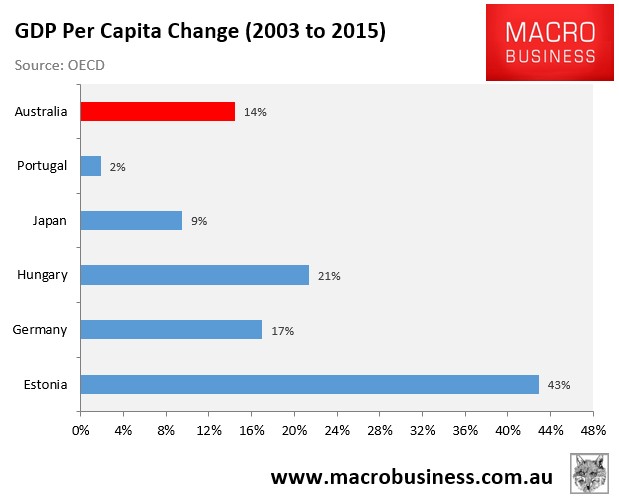
Australia’s GDP per capita growth also arguably flatters Australia, since it counts infrastructure investment that needs to be made simply to keep up with population growth but doesn’t actually benefit the incumbent population. As noted by Dr Jane O’Sullivan last year:
“Capital widening”, just to build more stuff so that a growing population maintains current levels of access to schools, hospitals and sub-30-minute commutes, is recurrent spending. It yields no improvement, from which its cost can be repaid. This is a major blind spot on economists’ analysis of population growth. If you’re going to count a new hospital on the positive side of the ledger, you need to count the crowding of the old one by population growth as a cancelling negative. Quick check: would we be no worse off if we didn’t build it? If the answer is yes, then it might be an investment. If no, then it’s a recurrent cost.What’s more, all that “capital investment” just to stand still is GDP that doesn’t enrich the existing citizens. It’s undertaken just for the sake of the people being added. If we were really interested in how the headline metrics relate to wellbeing, we should deduct the cost of “capital widening” from GDP (about 6.5% of GDP per 1% population growth rate) before dividing the rest per capita. Or better still, do that to Net National Income.
Then there’s the issue of unemployment, whereby Australia’s rate has sat above Japan’s for more than a decade:
Terry McCrann is spot on. Living standards of the incumbent Australian population is the threshold issue in the immigration debate. Living standards in the major cities are unambiguously being eroded by mass immigration via negative externalities that are not captured in the national economic accounts, such as increasing congestion, falling housing affordability, environmental degradation, etc.
Moreover, pursuing mass immigration is a growth fig leaf for governments and associated rent-seekers to pretend they’re doing the job rather than pursuing the more difficult but ultimately much wider benefits of productivity-directed reform.

